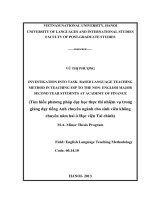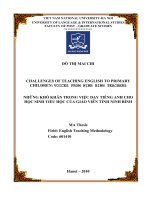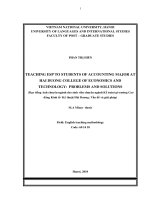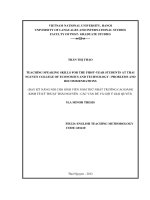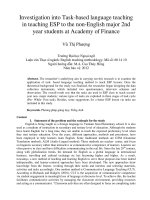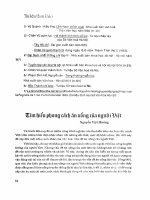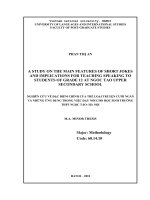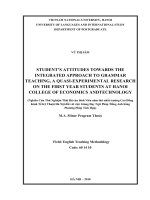Teaching ESP to students of accounting major at Hai Duong College of Economics and Technology Dạy tiếng Anh chuyên ngành cho sinh viên chuyên ngành kế toán tại
Bạn đang xem bản rút gọn của tài liệu. Xem và tải ngay bản đầy đủ của tài liệu tại đây (858.1 KB, 63 trang )
1
VIETNAM NATIONAL UNIVERSITY, HANOI
UNIVERSITY OF LANGUAGES AND INTERNATIONAL STUDIES
FACULTY OF POST – GRADUATE STUDIES
PHAN THỊ HIỀN
TEACHING ESP TO STUDENTS OF ACCOUNTING MAJOR AT
HAI DUONG COLLEGE OF ECONOMICS AND
TECHNOLOGY: PROBLEMS AND SOLUTIONS
(Dạy tiếng Anh chuyên ngành cho sinh viên chuyên ngành Kế toán tại trường Cao
đẳng Kinh tế- Kỹ thuật Hải Dương: Vấn đề và giải pháp)
M.A Minor thesis
Field: English teaching methodology
Code: 60 14 10
Hanoi, 2010
2
VIETNAM NATIONAL UNIVERSITY, HANOI
UNIVERSITY OF LANGUAGES AND INTERNATIONAL STUDIES
FACULTY OF POST – GRADUATE STUDIES
PHAN THỊ HIỀN
TEACHING ESP TO STUDENTS OF ACCOUNTING MAJOR AT
HAI DUONG COLLEGE OF ECONOMICS AND
TECHNOLOGY: PROBLEMS AND SOLUTIONS
(Dạy tiếng Anh chuyên ngành cho sinh viên chuyên ngành Kế toán tại trường Cao
đẳng Kinh tế- Kỹ thuật Hải Dương: Vấn đề và giải pháp)
M.A Minor thesis
Field: English teaching methodology
Code: 60 14 10
Supervisor: Lâm Thị Phúc Hân, M.A
Hanoi, 2010
6
TABLE OF CONTENTS
Certificate of originality of the thesis ……………………………………………………i
Acknowledgements ……………………………………………………………………… ii
Abstract ………………………………………………………………………………… iii
Table of contents. …………………………………………………………………… …iv
List of abbreviations …………………………………………………………………… vi
List of tables and charts. ……………………………………………………………… vii
PART A: INTRODUCTION. ……………………………………………………………1
1. Rationales ……………………………… … ……………………………….………. 1
2. Aims of the study ……………………………….………………………………………1
3. Methods of the study. ………………… ………….……… ………………………….2
4. Scope of the study ………………………………… …….… ………………………. 2
5. Organization of the study. ………………………… ………………… …….……….2
PART B: DEVELOPMENT. …………………………………………………………….3
CHAPTER 1: LITERATURE REVIEW …………………………………… …………3
1.1. Overview of ESP ……………………………………….… ……………….…… 3
1.1.1. Definition. …………………………… ………….………… ……………… 3
1.1.2. Classification of ESP. ………………………………… ……………………….4
1.2. Roles of ESP teachers ……………………………… …….…………… ……… 5
1.3. Development and approaches to teach ESP…….…………… ………… … … 6
1.4. Difficulties in teaching ESP. ………………….….……… …………… …… 8
CHAPTER 2: THE TEACHING CONTEXT. … ………………………….…………11
2. 1 ESP course and the objectives of teaching and learning ESP. … … …… 11
2. 2 The teachers. ……………………………………………… ………….……… 11
2. 3 The learners. ……………………………………………… ………… ………12
2. 4 The materials. ………………………………………………… … ………… 13
CHAPTER 3: RESEARCH METHODOLOGY. ………… …………….……… … 15
3.1 Research questions …………………………………………… ……………15
3.2 Participants. ………… …………….……… ….….… ……………….……… 15
3.3 Data collection instrument. ………… ……… ……… ……… … ………15
3.4 Data collection procedure. …………………….……………………… ………16
3.5 Data analysis procedure. ……………………… ………………… … ………16
7
CHAPTER 4: FINDINGS AND DISCUSSION. ……………………… …………… 17
4.1. Teachers’ and students’ attitudes toward the ESP course ……… … ……… 17
4.2. Difficulties in teaching ESP. ………………………………………… ………… 18
4.2.1.Difficulties in terms of teachers. ………………………………………… …… 18
4.2.1.1 Teachers’ background knowledge of the subject matter…… …………… 18
4.2.1.2 ESP teaching methodology. ……………………… ………………………19
4.2.2 .Difficulties in terms of students. ……………………………… ……………… 23
4.2.2.1. Students’ background knowledge ……… ……………………………… 23
4.2.2.2. Students’ competence in reading skill. …………………… ………………25
4.2.3. Difficulties in dealing with the current teaching material ……………… …… 26
4.3. Teachers’ and students’ expectations ………… 27
4.3.1. Teachers‟ opinions of the further training courses ………… …………….……27
4.3.2. Students‟ expectations in terms of teaching method …… ………….………….28
4.3.3. Teachers‟ and students‟ expectations in terms of teaching material. ………….29
4.3.4. Teachers‟ and students‟ views of using supplementary materials …… ………30
4.3.5. Teachers‟ and students‟ opinions about the time of ESP course. ……….… … 31
CHAPTER 5: RECOMMENDATIONS … ……………… ……………………… 32
5.1. Improving teachers’ professional knowledge. ……………………………… … 32
5.2. Improving ESP teaching methodology. 32
5.3. Improving teachers’ classroom techniques. …………………………… ……… .33
5.4. Helping students to enrich their background knowledge . …………….….…… 36
5.5. Developing teaching materials. ………………………………………….….…… 37
5.5.1. Adapting the current course book……………………………………….….…….37
5.5.2. Providing appropriate supplementary materials ……………….………… …….38
PART C: CONCLUSION …………………………………………….………….….… 39
1. Conclusion of the study. …………………………………….………… …….….….39
2. Limitations and suggestions for further study. ……… …………………….….….40
REFERENCES ……………………………………………………………………… …41
APPENDICES…………………………………………………………………………….I
Appendix 1: Questionnaire for the teachers ……………………………………………I
Appendix 2. Questionnaire for the students ……………………………………………V
Appendix 3: Sample. Unit 13: Liabilities ……………………………………………XIII
8
LIST OF ABBREVIATIONS
ESP: English for specific purposes
GE: General English
EAP: English for Academic Purposes
EOP: English for Occupational Purposes
HCET: Hai Duong College of Economics and Technology
No: Number
Ts: Teachers
Sts: Students
9
LIST OF TABLES AND CHARTS
Table 1: Teachers‟ training in Economics and Accounting fields.
Table 2: Teachers‟ frequency of enriching specialized knowledge
Table 3: The teachers‟ focuses in ESP lesson and students‟ responses
Table 4: Forms of practice in ESP lesson and students‟ responses.
Table 5: The frequency of using pre-reading techniques and students‟ responses.
Table 6: The frequency of using while-reading techniques and students‟ responses.
Table 7: The frequency of using post-reading techniques and students‟ responses.
Table 8: Students‟ background knowledge of subject matter.
Table 9: Students‟ English competence.
Table 10: Teachers‟ and students‟ opinions about the current course book.
Table 11: Teachers‟ opinions of the further training courses on Economics and
Accounting
Table 12: Students‟ expectations in terms of teaching method
Table 13: Teachers‟ and students‟ expectations in terms of material.
Table 14: The reasons for using supplementary materials
Table 15: Teachers‟ and students‟ opinions about the time of ESP course
Chart 1: Attitudes toward the importance of ESP course for the students‟ future job
Chart 2: Teachers‟ and students‟ opinions about the current ESP course.
Chart 3: Students‟ competence in reading skill from the views of teachers and students
Chart 4: Teachers‟ and students‟ opinions of using supplementary materials.
10
PART A: INTRODUCTION
1. Rationales
The turn of the century has witnessed the dramatic growth in Vietnamese economics and
the ensued reforms in its education sector, specifically, the reform of its language
education. In every school curriculum, English has become a compulsory subject and in
higher education, “English majors” have been set up in many Vietnamese universities.
English education then has since been divided into two phases; one being devoted to the
general education of English knowledge and the cultivation of English skills, the other
being devoted to English education for specific purposes. The coming into being and the
development of English for specific purpose (ESP) education can be seen as a natural
response toward the socioeconomic development of contemporary Vietnam and the
globalization of the international community. With the purpose of providing vocational
English knowledge in specific disciplines, the ESP courses train the graduates to become
the comprehensive language talents that are urgently needed in many sectors in today‟s
Vietnamese society
Being aware of the importance of ESP, Hai Duong College of Economics and Technology
(HCET) has introduced the ESP course into the college curriculum since 2002. Since then,
the teaching ESP at HCET has been improved, however, some problems in teaching ESP
have emerged and need to be solved. This current situation has aroused the author‟s
interest.
For the reasons above, the author has decided to carry out the study of “Teaching ESP to
students of accounting major at Hai Duong College of Economics and Technology:
problems and solutions”
2. Aims of the study.
The study aims at:
- Investigating the teachers‟ and students‟ attitudes toward the ESP course.
- Examining the difficulties in teaching ESP to students of Accounting major at
HCET
- Offering some suggested solutions for the current ESP course.
It is hoped that the findings of this study will make some contributions to the improvement
of teaching ESP at Hai Duong College of Economics and Technology in particular and
teaching ESP in general.
11
3. Method of the study.
In order to achieve the aims mentioned above, the author conducted the study in the form
of a survey research. The major method used in this thesis is quantitative one. All the
problems and suggestions given in this thesis are based on the analysis of data collected
from the questionnaires responded by both teachers and students at Hai Duong College of
Economics and Technology.
4. Scope of the study.
Teaching ESP is a broad issue. Due to the limited time, the researcher just focuses on the
problems in teaching ESP to the first - year students of Accounting major at Hai Duong
College of Economics and Technology. The problems explored are limited in terms of the
students‟ and teachers‟ background knowledge, teaching methodology and teaching
material.
In addition, the emphasis of the current ESP course is reading skill. Therefore, when
examining the problems concerning with teaching method, the researcher focuses on the
method of teaching reading ESP.
5. Design of the study.
This study comprises six chapters as follows.
Part A: Introduction presents the rationales for the study and set up the aims, the method,
the scope and the design of the study.
Part B: Development consists of 5 chapters
Chapter 1: deals with the theoretical background of the current study that is relevant to
the research topic including the overview of ESP, roles of ESP teachers, the development
and approaches to teach ESP and some difficulties in teaching ESP.
Chapter 2: describes the current situation of teaching and learning ESP at the Accounting
Department in HCET
Chapter 3: introduces the research methodology.
Chapter 4: focuses on analyzing the collected data and discussing the findings of the study.
Chapter 5: provides some suggested solutions for the current problems.
Part C: Conclusion summarizes the issues addressed and points out some limitations and
makes some suggestions for further research.
12
PART B: DEVELOPMENT
CHAPTER 1: LITERATURE REVIEW
Much time and energy has been devoted to the study of teaching ESP so far. This chapter
reviews some authors‟ viewpoints concerning with ESP and ESP teaching in order to build
up the theoretical background for the study, which consists of four main parts: overview of
ESP, roles of ESP teachers, development and approaches to teach ESP and difficulties in
teaching ESP
1.1. Overview of ESP
1.1.1. Definition.
Despite the fact that it is an approach which has been widely used over the last three
decades, there has been considerable recent debate about what ESP means. Definitions of
ESP in the literature are relatively late in time, if we assume that ESP began in the 1960s.
Hutchinson and Water (1987:19) emphasized that ESP should be seen as an approach, not
a product. It is an approach which is directed by specific and apparent reasons for learning.
Likewise, Strevens (1988: 1) stated that “ESP is a particular case of the general category of
special – purpose language teaching ”. He defined ESP by making a distinction between its
absolute and variable characteristics.
Four absolute characteristics are:
1- designed to meet specified needs of the learner;
2- related in content (that is in its themes and topics) to particular disciplines,
occupations and activities;
3- centered on language appropriate to those activities in syntax, lexis discourse,
semantics and so on, and analysis of the discourse;
4- in contrast with „General English‟.
Two variable characteristics are:
1- may be restricted as to the learning skills to be learned (for example reading
only);
2- may not be taught according to any pre-ordained methodology.
The second absolute characteristic may confirm the impression held by many teachers that
ESP is always and necessarily related to subject content. Dudley-Evans and St John (1998)
modified Strevens‟ definition by suggesting the following absolute characteristics and
variable characteristics.
The absolute characteristics are :
1- ESP is designed to meet specific needs of the learner;
13
2- ESP makes use of the underlying methodology and activities of the disciplines it
serves;
3- ESP is centered on the language (grammar, lexis, register), skills, discourse and
genre appropriate to these activities.
The variable characteristics are:
1- ESP may be related to or designed for specific disciplines;
2- ESP may use, in specific teaching situations, a different methodology from that
of general English;
3- ESP is likely to be designed for adult learners, either at a tertiary level institution
or in a professional work situation. It could, however, be used for learners at secondary
school level;
4- ESP is generally designed for intermediate or advanced students. Most ESP
courses assume basic knowledge of the language system, but it can be used with
beginners.
To sum up, all the above definitions show that ESP is a language skill course. However, its
domains not only relate to distinctive content, but also to discipline- specific lexis, genres
and registers (Munby, 1978). Therefore, in terms of ESP teaching methodology, there
could be some differences in comparison with that in the General Purpose English class.
1.1.2. Classification of ESP
Traditionally, ESP can be classified into two major groups according to when they take
place: English for Academic Purposes (EAP) and English for Occupational Purposes
(EOP). Robinson (1991) showed a distinction between these two areas in the following
tree diagram.
Pre-experience
EOP Simultaneous/ in- service
Post-experience
ESP Pre-study
For study in a specific discipline In-study
EEP/EAP Post-study
Independent
As a school subject
Integrated
Figure 1: ESP Classification by experience
(Robinson, 1991, taken from Dudley-Evans and St John, 1998:6)
14
The diagram above indicates that the specific ESP course will depend largely on whether is
it categorized as EAP or EOP. The divison of ESP into EAP and EOP according to when
they take place is very important because “they will affect the degree of specificity that is
appropriate to the course”. (Dudley-Evans and St John, 1998:6)
Another division of ESP divides EAP and EOP according to discipline or professional area
in the following way:
English for specific purposes
English for Academic Purposes English for Occupational Purposes
English
for
Academic
Science
and
Technology
English
For
Academic
Medical
Purposes
English
For
Academic
Legal
Purposes
English
For
Management
Finance and
Economics
Figure 2: ESP Classification by professional area
(Dudley-Evans and St John, 1998:6)
From the figure above, it is obvious that ESP which is taught to students of Accounting
major at Hai Duong college of Economics and Technology belongs to English for
Management Finance and Economics and it is a type of English for Academic Purposes.
1. 2. Roles of ESP teachers.
As ESP teaching is extremely varied, some authors (Dudley-Evans and St John, 1998) use
the term “practitioner” rather than “teacher” to refer to those who are in charge of ESP
teaching. This also emphasizes that ESP work involves much more than teaching.
According to Dudley-Evans and St John (1998), ESP practitioner can have several roles as
follows:
- The ESP practitioner as a teacher: ESP is a practical discipline with the most important
objective of helping students to learn. However, the ESP teacher is not in the position of
being the primary knower of the content of the material (Dudley-Evans and St John, 1998:
13). The students may know more about the content than the teacher. Therefore, the
English for
Professional Purposes
English for
Vocational Purposes
English
For
Medical
purposes
English
For
Business
Purposes
Pre-
Vocational
English
Vocational
English
15
teacher has the opportunity to draw on students‟ knowledge of the content in order to
generate communication in the classroom. ESP teachers need to have considerable
flexibility, be willing to listen to learners, take interest in the disciplines or professional
activities which the students are involved in, and to take some risks in their teaching.
- The ESP practitioner as a course designer and material provider: Dudley-Evans and St
John (1998:14) stated that it is rarely possible to use a particular textbook without the need
for supplementary material and sometimes no really suitable published material exists for
identified needs. Therefore, ESP practitioners often have to provide the material for the
course. This involves selection of published material, adapting material if it is not suitable,
or even writing it. ESP teachers also need to assess the effectiveness of the used teaching
material whether it is published or self-produced.
- The ESP practitioner as a researcher: In Dudley-Evans and St John‟s opinion (1998:15),
“Research has been particularly strong in the area of English for Academic Purposes” and
“ESP teachers need to be aware of and in touch with this research”; “those carrying out a
need analysis, designing a course, or writing teaching materials need to be capable of
incorporating the findings of the research, and those working in specific ESP situations
need to be confident that they know what is involved in”
- The ESP practitioner as a collaborator: It is believed that subject-specific work is often
best approached through collaboration with subject specialist. (Dudley-Evans and St John,
1998: 16). The fullest collaboration is where a subject expert and a language teacher team-
teach classes
- The ESP practitioner as an evaluator: The ESP practitioner is often involved in various
types of evaluation: testing the students, evaluating the courses and the teaching materials.
(Dudley-Evans and St John, 1998: 16). Doing these kinds of evaluation, especially through
discussion and on-going needs analysis can be used to adapt the syllabus.
In brief, ESP teachers as a practitioner have many roles in ESP teaching. Hutchison and
Waters (1987), hence, assumed that “adaptability” and “flexibility” are the foremost
requirements of an ESP teacher.
1. 3. Development and approaches to teach ESP
In the past forty years or so, for ESP to attain its current status, five phases have evolved.
The first stage took place mainly in the 1960s and early 1970s. This stage was marked by
the register analysis, called the register analysis approach. Analyzing specific registers
aimed at identifying the grammatical and lexical features. These features were taken into
16
teaching materials. In fact, several early ESP materials designers analyzed large corpora of
specialized texts to establish the statistical contours of different registers.
The reaction against register analysis in the early 1970s brought about the concept of text:
the discourse analysis, which focused on the communicative values of discourse rather
than the lexical and grammatical properties of register. Allen and Widdowson (1974) set
out the approach and made it a major development in ESP in the 1970s. They introduced
the basic hypotheses of this stage that the learners‟ needs “can not be met by a course
which simply provides further practice in the composition of sentences, but only by one
which develops a knowledge of how sentences are used in the performance of different
communicative acts” Therefore, the discourse analysis approach focused on the way
sentences are used in the performance of acts of communication and developed materials
based on functions. Such functions included definitions, generalizations, inductive
statements, deductive statements, descriptions of processes, descriptions of sequences of
events, and descriptions of devices. Nevertheless, the discourse analysis approach soon
came under attack for being too fragmentary to combine these functions to make longer
texts. Robinson (1981) stated that "We are given little idea of how these functions combine
to make longer texts." The concept of text - the genre analysis approach - came to make up
for this shortcoming. This approach considers text as a total entity, rather than a collection
of unrelated units. Hutchison and Waters (1987:11) conveyed the idea in the following
way: "…but now attention shifted to understanding how sentences were combined in
discourse to produce meaning”. This, as Johnson (1993) said, can be achieved by seeking
to identify the overall pattern of text through a series of phases or moves.
In the mid-1970s, materials developers came to see learners' purposes rather than specialist
language as the driving force behind ESP. The conception of need - the target situation
analysis - was to lead the way. This phase did not add anything new to the knowledge
about ESP but set the exiting knowledge on a more scientific basic by “establishing
procedures for relating language analysis more closely to learners‟ reason for learning”
(Hutchinson and Water, 1987:12). The learners‟ needs since then have been placed at the
center of the course design process.
All the above stages of the developments of ESP focus on the surface forms of the
languages (at the sentence level or beyond the sentence), the next stage has attempted “to
look below the surface” and “consider not the language itself but the thinking processes
that underline language uses” (Hutchinson and Water, 1987:13) This stage drew attention
17
to skills and strategies – the skills-centered approach. The focus of this approach should be
on the underlying interpretive strategies rather than on the surface forms of the language
and “a focus on specific register subject is unnecessary in this approach because the
underlying processes are not specific to any subject register” (Hutchinson and Water,
1987:13)
Finally, the attention to strategy analysis gave rise to a new generation of ESP materials
based on the conception of learning, that is, learning-centered approaches:
"Our concern in ESP is not with language use-although this will help to define the
course objectives. Our concern is with language learning. We cannot simply assume
that describing and exemplifying what people do with language will enable someone
to learn it …. A truly valid approach to ESP must be based on an understanding of
the processes of language learning." (Hutchinson and Waters, 1982:14)
In short, the development of ESP is in accordance with the development of ELT. Moving
from the register analysis to a more task-based and learning- centered approach, ESP today
is a branch which is gaining increasingly important role in both academic and business
world.
1. 4. Difficulties in teaching ESP
According to Robinson (1991), teachers may encounter many problems in number of
aspects of ESP teaching. The difficulties come from students, teachers themselves,
teaching materials and other teaching and learning conditions.
Firstly, teachers have problems in teaching ESP to students of different language
background. Strang (1972) asserted that the readers would have different levels of
comprehension of the same text because they start from different positions. Moreover,
Dudley-Evans and St John (1998:5) stated “ESP is generally designed for intermediate or
advanced students. Most ESP courses assume basic knowledge of the language system”.
However, many students do not acquire that level of language proficiency when they take
ESP course, though they have taken part in General English course before. As a result,
ESP students are not motivated enough to learn ESP. In Vietnam, this problem becomes
worse because not all students study English at school and normally, there is a big gap in
terms of language proficiency between students from big cities and ones from rural areas.
The second problem concerns with teachers themselves. According to Hutchison and
Waters (1987:161), ESP teachers “must know something about the subject matters of ESP
materials”. It means that ESP teachers must acquire the basic knowledge of the subject
18
matter. However, many ESP teachers have limited background knowledge of specialized
subjects. Most ESP teachers are shifted from General English teaching. “They need,
therefore, to orientate themselves to a new environment for which they have generally been
ill-prepared” (Hutchison, 1987: 157). Robinson (1980:83) also mentioned this problem of
the ESP teachers as “lack of sufficient preparation time”. The major problem that ESP
teachers deal with is teaching method. Dudley-Evans and St John (1998:4) stated that “all
ESP teaching should reflect the methodology of the disciplines and professions it serves”
and “interaction between teacher and learner may be very different from that in general
English class”. It means that “ESP teaching has its own methodology”, which must be
different from that of General English teaching. Teaching methods must be learner
oriented. In other words, ESP is concerned, first and foremost, with satisfying the real
needs of the students and not with revealing the knowledge of the teacher. Therefore, the
intensive and efficient teaching of grammar, vocabulary, translation, etc. must be
scientifically grounded and concentrate only on those items which students actually need
for the purposes specified at the beginning of the university or college course. This is an
important statement which, in theory, is universally accepted but in practice is hardly ever
followed.
Another aspect connected with difficulties in teaching ESP is teaching and learning
material. According to Tom Hutchinson and Alan Waters, “the ESP syllabus is usually
derived from a detailed analysis of the language features of the target situation” (Tom
Hutchinson and Alan Waters, 1987: 92). However, many ESP materials have been limited
to specialized lexicon and sentence structures . This demonstrated that the ESP syllabus
designers have ignored learners‟ personal interests when designing these materials. This, in
turn, resulted in learners‟ low motivation in English studies and poor performance later
when they started to use English in their future profession.
Some other teaching and learning conditions may be the challenges for both teachers and
students such as the class size, teaching and learning equipments, psychological factors, etc.
Teachers have problems in teaching in large classes. There is a fact that large class has
negative impact on both teaching and learning, not only in EGP but also ESP course. Large
class size reduces students‟ participation, and leads to lowered motivation. Or, considering
psychological factors, learning a foreign language, like no other subjects, requires a special
psychological approach, the atmosphere of relaxation, trust even love and faith. Indeed,
learning a strange language, a strange world picture, strange (often – alien) mentality is a
19
difficult psychological barrier for many learners. Teaching foreign languages to students of
non-philological specialities is complicated by the fact that for these students a foreign
language is not a part of the special, professional education, which may result in a lack of
motivation.
To sum up, this chapter has presented a brief theoretical background of ESP regarding the
definition, classification, roles of ESP teachers as well as the development and approaches
to teach ESP. This chapter has also reviewed some difficulties that ESP teachers may cope
with when teaching ESP.
20
CHAPTER 2: THE TEACHING CONTEXT.
This chapter describes in detail the context of the study, which is a description of ESP
course and the objectives of teaching and learning ESP, the students, the teachers and the
ESP materials used at HCET.
2.1. ESP course and the objectives of teaching and learning ESP.
At Hai Duong college of Economics and Technology ESP, the compulsory subject in the
college curriculum, is introduced to the first year students of Accounting Department in the
second term. The time for ESP course is 75 periods. The course must totally cover 17
units, each of which lasts from 4 to 5 periods, in the course book “English for Economics
and Accounting” (see 3.1.4). Students learn ESP in large classes with more than 60
students. Each week, they have 3 or 5 periods to study ESP.
At Accounting Department, ESP, though compulsory, is not considered as a main subject.
In addition, the target of teaching ESP for students of Accounting major is to provide them
with English in Economics and Accounting; that is, after ESP course, students are able to
read books and materials related to their major. Therefore, teaching ESP aims at improving
students‟ reading skill and familiarizing them with specializing English language in
Economics and Accounting fields.
For the students of Accounting major, taking part in the ESP course can satisfy their own
needs. The first and foremost purpose is to pass the final exam at the end of the term to
complete the college curriculum. Besides this, they study ESP to meet the demand of the
society, which is language competence, in order to find a good job after graduation.
In short, the objectives of ESP courses is to provide students with basic knowledge of
English used in specific fields such as Economics and Accounting.
2.2. The teachers.
All ten teachers of English in our college are qualified. They all have university degrees.
Among them, one has had the Master degree in English, two are doing the Master course
in English.
All the teachers have been responsible for the teaching of both General English and ESP.
However, they are all willing to take up ESP teaching although none of them has been
trained in teaching ESP. They, therefore, face many difficulties: the lack of professional
knowledge and the way to choose an appropriate teaching methodology.
In terms of methodology, the teachers in our college usually employ the traditional
methods of teaching especially Grammar-translation method. They often apply this method
in teaching General English courses, even with the textbook designed according to
21
communicative approach as New Headway. In other words, they focus on analyzing the
grammar rules, not on the acquisition of language skills. In ESP course, due to the features
and contents of the text book (see 3.1.4), the requirement of the ESP course is to teach
mainly reading skill to all students. However, ESP teachers at HCET, who are used to
traditional teaching method, spend most of the classroom time explaining new
terminologies, analyzing grammar structures and translating texts into Vietnamese.
Students often listen and take notes passively. This leads to low motivation in students and
creates very few chances for them to improve their communicative competence, especially
in their major.
2.3. The learners.
There are several specific features relating to the students of Accounting major at Hai
Duong college of Economics and Technology. First, all of them study ESP as a
compulsory subject of their academic studies. They start to learn ESP in the second term of
the first year. In the first term, they study General English course using New Headway
Elementary by John & Liz Soars. Therefore, they are supposed to acquire the most basic
English at the Elementary level. Second, it is difficult to say that their language
competence is of the same because they all failed the university entrance exam and were
enrolled in the college, basing on the total marks of Maths, Physics and Chemistry, which
they got in university entrance exam. As a result, many of them are at the low level of
English proficiency. Another fact is that most of the students are from rural areas in Hai
Duong province, some from Hai Duong city and very few from other provinces.
Consequently, individual differences in learning styles, identities, attitudes, motivation, etc
are unavoidable and may cause the teachers some problems during their ESP teaching
In addition, those students start to learn ESP without having learnt any specialized subjects.
This, according to Marry Schleppegrell and Brenda Bowman (1986:7), does not “enhance
their ability to acquire English” because, in Marry Schleppegrell and Brenda Bowman‟s
opinion, “subject matter knowledge gives [the students] the context they need to
understand the English of the classroom”. In other words, when the students lack
knowledge of their major, they will have difficulties in ESP classroom
Apart from that, students at HCET have problems in learning ESP reading, which is the
most focused in the ESP course. The reason is that, in General English course, reading skill
is ignored and all the reading texts are only for reference. Therefore, students are lack of
reading skill competence when learning ESP reading.
22
Another problem is their bad habit of learning. Many students tend to depend too much on
the given textbook and the teachers for knowledge. This dependent habit of learning makes
them more passive in English class.
2.4. The materials.
It is known that there are two sources of materials in teaching and learning ESP, which are
published materials and in-house materials. The published materials have been officially
published and are available in the markets. These materials are written by the experts who
have a lot of experience and expertise in the specific field. Obviously, this kind of
materials is useful for both teachers and students. However, they are often criticized for not
satisfying students‟ specific needs. The second kind of ESP materials is in –house
materials which are collected form various popular books by the teachers in the college.
The writers of in-house materials understand well the situation of teaching ESP to their
students, so the texts in these textbooks were shortened and simplified and adapted to fit
the language level of students. Therefore, it can be said that this kind of materials can make
up for the shortcoming of the published textbooks.
The material “English in Economics and Accounting” used to teach students of
Accounting major is in- house material. However, the problem is that this material is also
used for students of Economics major. It is the collection of seventeen reading texts taken
mainly from two books: English in Finance (Cao Xuan Thieu, 2006) and English in
Economics and Business (Sarah Bales, Do Thi Nu & Ha Kim Anh, 2003), with topics
related to both Economics and Accounting fields. However, the topics in Economics are
not the interests of students of Accounting major. This does not only lead to students‟ low
motivation but also causes them many difficulties when using the textbook.
The current course book consists of seventeen units. Each unit is divided into four parts.
The first and also the most important part is the reading text with comprehension questions.
Each reading text is adapted in such a way that makes the content “learnable” to all
students. The second part is the language focus. This part explains some grammatical
points in the reading text. There are also some related exercises for students to practise.
The third part is word-study with some vocabulary exercises designed for students to
practice the new terminologies in the reading text such as matching, gap-filling. At the end
of each unit are some new words or terminologies extracted from the reading text with the
Vietnamese equivalences.
The textbook is rather ineffective in some ways. Firstly, the material focuses only on
reading and writing. Other skills are neglected. Secondly, it is rather monotonous as it
23
provides students with the same types of exercises to practice. In this current course book,
comprehension questions and the same kinds of word-study exercises are found in every
unit. Finally, some topics in this material are not related to students‟ major. The topics in
Economics are not the major concerns of the students at Accounting Department. This
shortcoming demotivates students.
In summary, although it has a number of good points, the current ESP text book for
students of Accounting major does not satisfy both teachers and students at HCET. Basing
on these facts the researcher carried out the study following the research methodology
which is mentioned in the next part.
24
CHAPTER 3: RESEARCH METHODOLOGY
This chapter clarifies the methodology that the researcher used to conduct the study, which
includes a thorough description of respondents and of the way data were collected as well
as the analytical procedure to draw conclusions.
3.1. Research questions.
Before presenting a thorough description of the participants, data collection instrument,
data collection procedure and data analysis procedure, it is necessary to reconfirm that the
study was conducted to answer the three following research questions:
- What are the teachers‟ and students‟ attitudes toward the ESP course?
- What are the difficulties in teaching ESP to students of Accounting major at HCET?
- What do teachers and students expect to change for the current ESP course?
3.2. Participants.
The target population for this study comprises 1053 students at Accounting Department
and 10 teachers of English at Department of foreign languages in HCET. The sample
included 7 full-time teachers of English who have taught ESP and 100 first year students at
Accounting Department, who were selected at random from 4 classes: K90301, K90203,
K90303, K90304
The participants in the survey were those who have taught ESP and 100 students. All the
teachers were female and have had at least two or more years‟ experience teaching ESP.
Six teachers were ranged in age from twenty- seven to thirty- six. Only one teacher was at
the age of forty-nine. They all have had Diploma degree in English. One teacher had the
Master degree and one was taking the Master course in English.
100 students involved in this study were the first year students. Of these 100 students, 75
of them were female and 25 of them were male. Their age ranged from 19 to 23. All the
students have been learning English for at least 3 years or more. The study was conducted
at the end of the second semester in the first school year. Thus, the students were likely to
finish the ESP course.
3.3. Data collection instrument.
Questionnaire is chosen as a form of data collection instrument. Two forms of survey
questionnaires were devised for two groups of respondents (one for teachers, one for
students). Most questions were multiple-choice questions. 13 questions written in English
were designed for teachers and 13 questions written in Vietnamese were for students. The
survey questionnaire aimed at seeking information concerning:
- Teachers‟ and students‟ attitudes toward the ESP course.
25
- Teachers‟ background of the subject matter.
- Students‟ background of the subject matter and students‟ language competence.
- The teaching method employed in ESP lesson
- Teachers‟ and students‟ views about the current course book.
- Teachers‟ and students‟ expectations for an effective ESP course.
As mentioned in part 3.1.1, the emphasis of teaching ESP at HCET is ESP reading skill.
Therefore, in order to find out the teachers‟ methodology in ESP lesson, the author
designed the questions about the teachers‟ focus in ESP lesson, the forms of practice and
the techniques used in teaching reading ESP.
3.4. Data collection procedure.
Data collection was conducted via questionnaire for both teachers and students. First, the
author developed the questionnaire basing on three aspects, which were considered before
the survey, including attitudes toward ESP course, difficulties in teaching ESP and
expectations for an effective ESP course. Then, the data were collected during the last
week of ESP course. The researcher met students in class time, explained the pedagogical
goal of the survey and asked them to answer the questionnaire. Differently, the teachers
were requested to complete and return the questionnaire in one week to ensure that they
would have enough time to give detailed and accurate information.
3. 5. Data analysis procedure.
The data collected from the questionnaires for teachers and students are synthesized in the
form of tables and charts. The percentage method has been used because it has the
advantage of ease and clarity. Because of the relatively small size of the sample, there is no
need to use sophisticated statistical methods.
The results of questions in questionnaire are presented by ratios of options chosen and are
analyzed in detail in the next chapter.
26
CHAPTER 4: FINDINGS AND DISCUSSION
This chapter is a detailed analysis of collected data. The data will be presented in tables
and charts in order to answer three research questions about the teachers‟ and students‟
attitudes toward the ESP course, the difficulties in teaching ESP and expectations for an
effective ESP course.
4.1. Teachers’ and students’ attitudes toward the ESP course
These two charts below summarize the answers to the first two questions in two
questionnaires ( see appendix 1 and appendix 2).
0%
20%
40%
60%
80%
100%
Very important Important Not important
Teachers
Students
Chart 1: Attitudes toward the importance of ESP course for the students’ future job
As can be seen from chart 1, the majority of the teachers and students ( 71.4% and 75%
respectively) shared the same idea that ESP course was very important for the students‟
future job. The scale of „important‟ reached the agreement of 28.6 % of teachers and 25%
of students. None of them thought that ESP was not important. This result can be explained
by the fact that both teachers and students at HCET are aware of the job requirements in
today‟s society, which is an urgent need for the comprehensive language talents in each
specific discipline. Thus, they consider ESP important.
27
0%
20%
40%
60%
80%
100%
Difficult Ok Easy
Teachers
Students
Chart 2: Teachers’ and students’ opinions about the current ESP course.
Chart 2 shows that 71.4 % teachers and 79% of students thought that ESP was a difficult
subject for the first year students. None of them (0%) considered it “easy”. This could
result from the fact that ESP is taught quite early in the academic curriculum (in the second
term of the first school year). Therefore, the knowledge about the subject matter remains
limited. In addition, their low level of English proficiency is a real challenge for them to
learn a new academic subject in English.
4.4. Difficulties in teaching ESP
Questions 3 to 9 (in appendix 1 and 2) were used to seek the answer to the second research
question, which is about the difficulties in teaching ESP to the first year students of
Accounting major at HCET. The data collected are analyzed basing on 3 aspects:
difficulties in terms of teachers, in terms of students and in terms of teaching material
4.4.1. Difficulties in terms of teachers.
4.2.2.1 . Teachers’ background knowledge of the subject matter
Table 1: Teachers’ training in Economics and Accounting fields.
As regards the teachers‟ knowledge of Economics and Accounting fields, which is
presented in table 1, 100% of teachers asked said that they had never been trained or taken
any course in Economics or Accounting before. This fact causes many difficulties when
they deal with new terminologies in a text as well as its content. As a result, they can not
make them comprehensible to the students.
Opinion
Numbers of teachers
Percentage
Yes
0
0%
No
7
100%
28
Ways to enrich knowledge
Usually
Sometimes
Never
No
%
No
%
No
%
Reading books in Economics and
Accounting
4
57.1%
3
42.9%
0
0%
Searching on Internet
4
57.1%
2
28.6%
1
14.3 %
Asking lecturers in the college
1
14.3%
4
57.1%
2
28.6 %
Attending the Economics or
Accounting lessons with students
0
0%
2
28.6%
5
71.4 %
Table 2: Teachers’ frequency of enriching specialized knowledge
Table 2 indicates how often the teachers enrich their specialized knowledge. It can be seen
clearly from the table that most of ESP teachers (57.1%) usually read books in Economics
and Accounting and searched the related information on Internet. Only one teacher replied
that she never accessed the Internet. The explanation for this fact is that books and internet
are available nowadays, teachers find it easy to get the useful information by these forms.
Meanwhile, only 14.3% of the teachers chose asking lecturers of accounting as a way they
usually enrich their knowledge and a majority of them (71.4%) did not prefer to attend the
Economics or Accounting lessons with students. It can be said that although ESP teachers
at HECT are not trained in Economics or Accounting fields, most of them are active to
enrich their knowledge of the subject matter. However, in order to self- equip the basic
knowledge of the subject matter, the teachers need to be more active and should employ
various ways to enhance their knowledge.
4.2.1.2. ESP teaching methodology.
The methodology employed in ESP lesson is presented in the teachers‟ focuses in ESP
lesson, the forms of practices and the techniques that teachers use in an ESP lesson.
To the question of the teachers‟ focuses of teaching ESP (see question 6 in appendix 1 and
2), more than one choice is acceptable. Table 3 displays the percentage that opinions are
chosen.
Opinion
Teachers
Percentage
Students
Percentage
Terminologies in English
6
85.7 %
89
89 %
Grammar
5
71.4 %
63
63 %
Specialized knowledge
2
28.6%
20
20 %
Language skills
1
14.3 %
15
15 %
Table 3: The teachers’ focuses in ESP lesson and students’ responses
